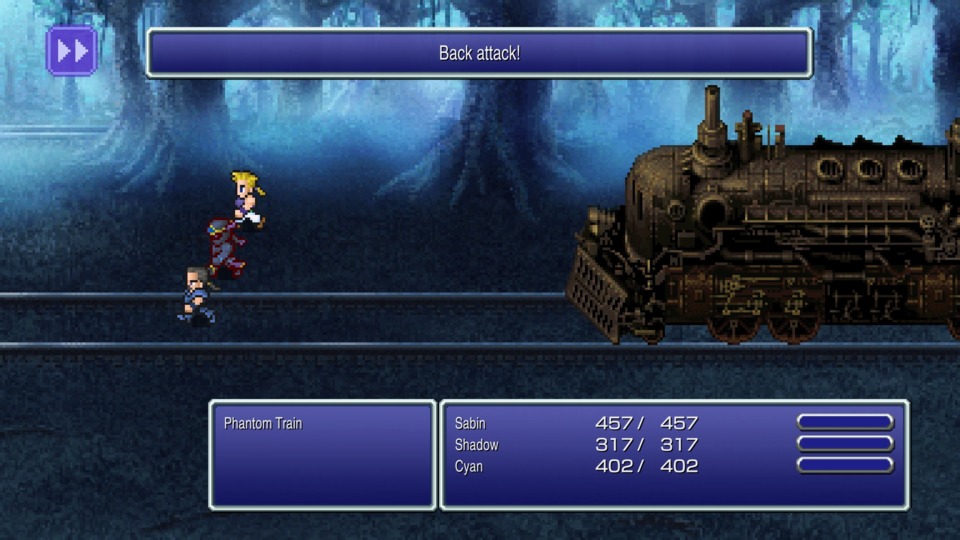Finishing Final Fantasy VI - Episode 1: Is This The Greatest Video Game Introduction? (Also A VI Pixel Remaster Review)
By ZombiePie 15 Comments
- Part 1 of Final Fantasy I series
- Part 1 of Final Fantasy II series
- Part 1 of Final Fantasy V series
- Part 1 of Final Fantasy VII series
- Part 1 of Final Fantasy VIII series
- Part 1 of Final Fantasy IX series
- Part 1 of Final Fantasy X series
- Part 1 of Final Fantasy X-2 series
- Part 1 of Final Fantasy XI series
- Part 1 of Final Fantasy XII series
- Part 1 of Final Fantasy XIII series
- Part 1 of Final Fantasy XIII-2 series
Preamble

On June 19th, 2015, I decided to embark on a blogging experiment. That day marked the first genuine attempt in my life not just to play a Final Fantasy game but to complete it. Since then, I have completed more than fifteen retrospectives and specials examining the Final Fantasy franchise and its supporting media. It's weird to think a one-off joke series I did on a dare has gone on to define my writing contributions on this website. Before the Final Fantasy series, I penned weekly updates to the Community Spotlight with the occasional gaming or off-topic forum thread to mix things up. Then I did a written Let's Play series on Final Fantasy VIII, and everything changed. The site has undoubtedly transformed in those seven years, and so have I. Looking back at some of my older works, I can honestly say it wasn't until recently that I found my "voice." Many of the earlier blogs, at least to me, are unreadable because they pine for surface-level criticism with a hostile and boisterous voice, a common theme on the internet circa the mid-2010s.
I would also be lying if I did not concede that this blog series of mine went through an existential crisis about a year ago. When things started, the gimmick involved me, a relative novice to JRPGs, trying entries in the Final Fantasy franchise for the first time and sharing my outsider impressions. Then, when I capped off Final Fantasy XII, a few users chimed in that I had, at that moment, reached an exciting milestone. By that point, I had completed more Final Fantasy games than most of the JRPG enthusiast crowd in the community. Around that point, I also butted heads against some members of the r/FinalFantasy community. I was not prepared for users on Giant Bomb to turn to me to share how I felt about Square-Enix, especially before their E3 presentations. I silently changed course without anyone noticing and decided to keep the series a Giant Bomb "exclusive." And trust me, getting your writing known on the internet is HARD. Right now, it is the hardest it has ever been. When the site first launched, making these silly long-form essays could draw up to fifty to sixty original comments in a single post. Now, I'd be lucky to get one-third of that. When I thought about possibly writing one of these retrospectives for the last time, I had to think about which game would be the most suitable to send it off on the best note.
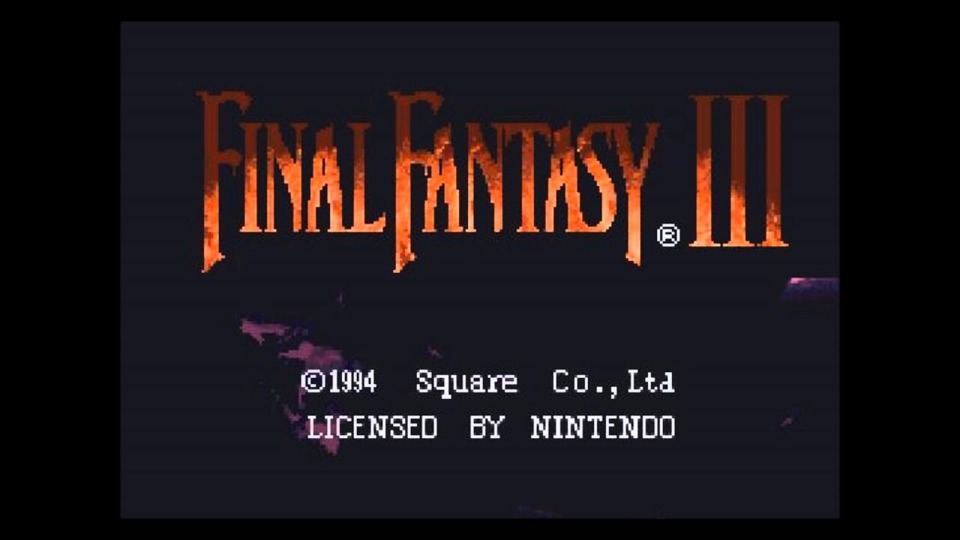
And now, here we are, Final Fantasy VI. I couldn't honestly tell you why I did not tackle Final Fantasy VI earlier. Part of me wants to say that I find it easier to close read the more modern entries in the series. Likewise, something about the game intimidated me. It is universally beloved, and my prior experiences sharing even the most remote criticisms for cherished JRPGs haven't gone as smoothly as I expected. For reference, check out my retrospective on Final Fantasy XII. Related was my fear that I wouldn't be adding anything new to a discussion that has been raging for over twenty years. Go to YouTube or any gaming website and search "Final Fantasy VI." You'll find exhaustive retrospectives and video essays examining every part of Final Fantasy VI with a proverbial magnifying glass and opining about what the writers and developers intended. How in the world can I, an amateur video game blogger, ever hope to compete against works of writing and video editing like that?
Then, when the Pixel Remaster for Final Fantasy VI finally came out, I said to myself, "Fuck it, I just want to play a 'good' video game." So, here we are; I am playing and writing about Final Fantasy VI, one of the most treasured video games ever made. I cannot guarantee that my experience or opinions about this game will match yours. If you have it in your heart to follow me as I attempt to complete the game, I greatly appreciate it. If you read this first episode and realize my writing style or main takeaways are not your cup of tea, that's also okay. I'm writing this blog for me, and if it resonates with even one person, that's cake. Without further ado, let's jump into it!
Part 1: The Pixel Remaster Of Final Fantasy VI Is Really Good
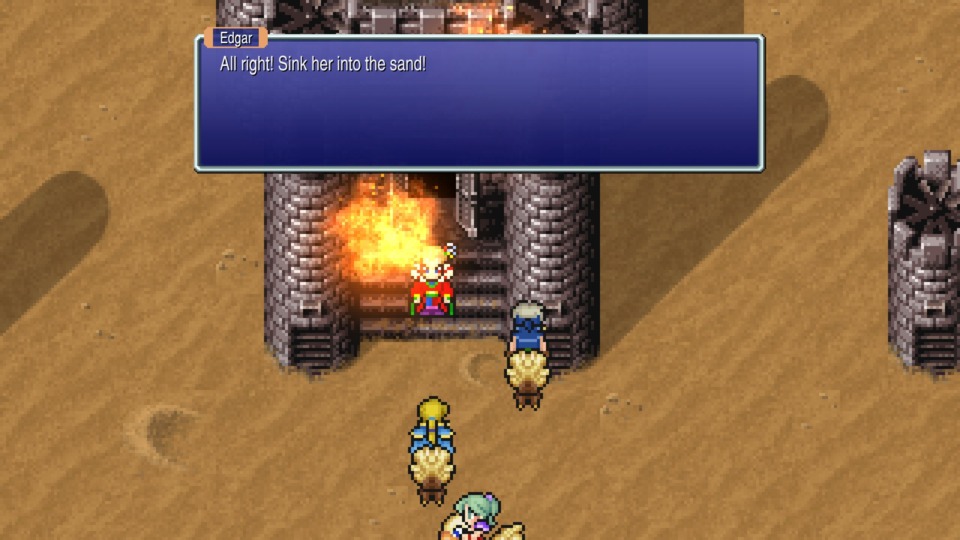
I mentioned earlier that I played the Pixel Remaster for this blog series. It is worth noting that I initially played Final Fantasy VI through the iOS/Android version for a podcast. With the release of the Pixel Remaster at the time still nebulous when I first started writing, I contemplated using that version for this series. As you might guess, I don't think that port is good. The smoothed graphics are awful, and some of the more complicated environments are a pain to navigate. The intricate layers and levels of Narshe, for example, all blur together and become impossible to discern at times. I did appreciate some of the quality-of-life additions in that version, which are notably absent in the Pixel Remaster. Playing the game at three times speed or without random encounters on tap was welcomed even if it gutted the utility of certain characters or relics. Even then, the game is goddamn ugly. I am a forefront defender of video game preservation. Nevertheless, Square-Enix shit-canning those ports for the Pixel Remaster versions was a necessary evil for the betterment of society.
And before I ramble about the several nitpicks I have with the Pixel Remaster for Final Fantasy VI, I need to make something obvious to everyone reading this blog. The Pixel Remaster of Final Fantasy VI is the game's DEFINITIVE version. If someone were to walk up to you and ask about Final Fantasy VI and how to play it, you SHOULD direct them to this version. Suppose you tell them to play the original SNES version of the game. In that case, you are a monster, especially if you expect them to get into retro gaming without guidance and respect for their wallet. Do you want to know a slight touch that blew my mind with the Pixel Remaster? Suppose you input one incorrect button prompt with Sabin's Blitz Command. In that case, the Pixel Remaster lets you try again instead of forcing you to whiff on the move! There's a mini-map on the upper right part of the screen whenever you enter a town, and it highlights the buildings that are shops! Do you know how much time these two minor edits save players in the long run? The in-game manual has been revised to make it immensely more helpful. The auto-save feature ensures you always have a save ready to load from before a battle, even with random encounters. That's right; you never have to live in fear of a Hell Gigas rocking your party in Zozo and needing to restart from scratch.
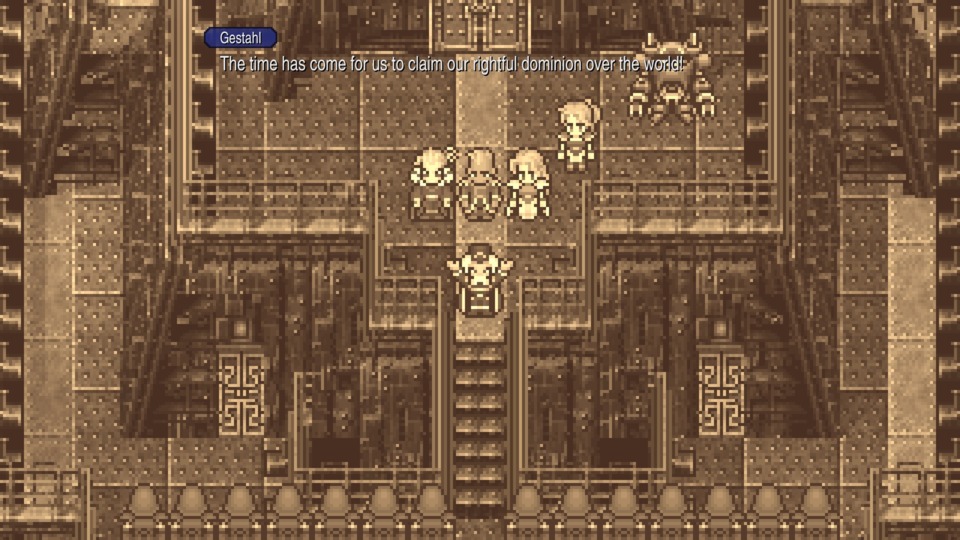
Unfortunately, Square-Enix has made some incredibly curious design decisions with their Pixel Remasters, and Final Fantasy VI is no exception. The first and most controversial of these is the default font choice, and it deserves all of the criticism it has gotten at this point. I will use the default font throughout this blog to reference what the game is like out of the box. I have no idea what Square-Enix was thinking with this font choice, but it sucks. Anyone can do a simple Google search for "16-bit fonts" and find free art assets a thousand times better than those used here. One of the reasons the default font is so bad is that it is a non-bolded sans serif font. As a result, when the game displays text during cutscenes without a dialogue prompt, the text can be nigh unreadable. For those who have not played Final Fantasy VI, during in-game cutscenes, flashbacks, and internal monologues, the game has lines of dialogue displayed without a background. These scenes are among the most important in the game, especially during the World Ruin, and they are sometimes illegible.
There are two other niggling nitpicks I'll address now about the Final Fantasy VI Pixel Remaster. The first of these has to do with the game's brightness. I know the Final Fantasy VI Pixel Remaster uses some of the technology used for Octopath Traveler for specific backgrounds and cutscenes. For the most part, the added graphical fidelity works, but something got lost in translation: shadows. Especially when you enter the World of Ruin, the Pixel Remaster lacks the spookier and moodier shadows that add so much depth to some of the game's levels and dungeons. For example, when you enter Zozo, the environment feels far less intimidating because you can see everything without overbearing shadows. However, this problem's most significant victim must be the World of Ruin. This issue needs to be seen in person, but the Pixel Remaster's version of the World of Ruin feels less impactful because it has the same brightness as the World of Balance. Something the original SNES version perfectly conveys is an overbearing sense of Kefka bringing forth an era of darkness. The World of Ruin there didn't just feature a yellow filter and swap around the location of cities. It felt morose and melancholy, and it's a bummer that the Pixel Remaster couldn't help itself with its fancy new graphics.
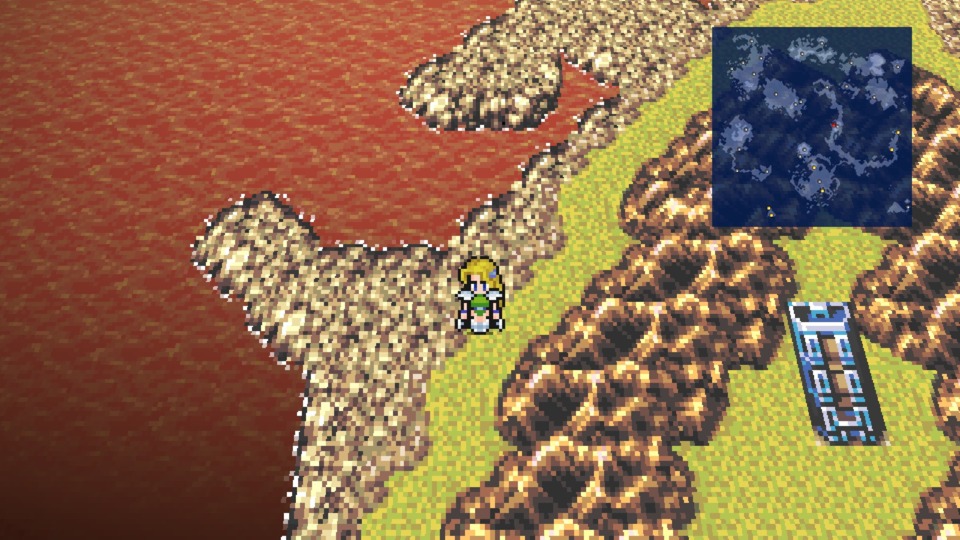
The other issue is what isn't in the Pixel Remaster. I don't know why they cut the GBA content from every Pixel Remaster. However, the extra dungeons and espers should be here. If Square-Enix continues to bill these ports as the "definitive" versions of these experiences, why not include content exclusive to previous ports? And before you chime in that it might be a rights issue, even the Android/iOS ports had the Dragons' Den! And you know what? I would have liked to have seen a Pixel Remaster take on the PSX cutscenes and cinematics! Why not? This version will be many people's first impression of a revered classic! Why not include everything? All of this grousing aside, I highly recommend the Pixel Remaster for Final Fantasy VI. It is the most fun, and accessible this game has been without as many downsides as previous port jobs. It is STILL fucking wild none of the Remasters have made consoles yet, shit fonts or not. But, if you have a PC or mobile phone capable of running it, check it out!
Part 2: No, Seriously, This Introduction Is AMAZING!
Sorry, but I lied about not complaining about the Pixel Remaster for most of this blog. We must talk about how they completely fucked up the opening scene. As has already been reported, the Final Fantasy VI Pixel Remaster does not play the introductory credits during the Megitek Armor march to Narshe. What you get right out of the box is a slow contextless trudge with characters you barely know for the same amount of time as if the credits were playing, but with zero text. Now, of the many curious decisions in the Pixel Remaster, this is one I can at least understand conceptually. Almost all of the people behind the original game no longer work for the company. Regardless, there were so many alternatives at Square-Enix's disposal for this scene that I still find its current state unforgivable. For example, why not change the old credits to ones that reflect the Pixel Remaster-specific design and programming team?
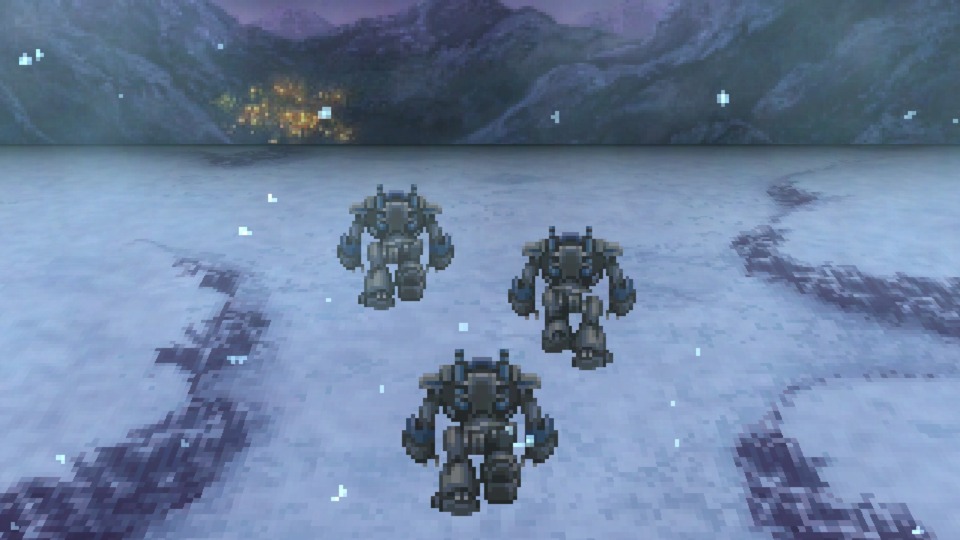
Other than that, it's a fucking incredible sequence in totality and still stands as one of the most outstanding introductions to a video game. It is one of the starkest reminders of Squaresoft always being on the cutting edge of graphical prowess and direction short of maybe Final Fantasy VII. Squaresoft was on their fucking A-GAME for years and people today need to be reminded of that fact. This point is a shocker, but compare the release date of Final Fantasy IV to Final Fantasy X and realize they are only ten years apart. For a ten-year crease, this franchise was unbelievably good. Final Fantasy VI was, to many gamers, the moment they first realized that. The way the game starts feels like a victory lap by Square. By this point, Mode 7 was a well-established feature on the SNES but with known limits and issues. And yet, Squaresoft used it liberally whenever they felt like it. The parallaxing horizon and the slow reveal of Narshe give you a clear sense of lumbering through a snowfield before you reach your mission objective. The rest of the opening is so dense that a friend of mine aptly pointed out that it feels as if the game is stunting.
With a green-haired woman as your avatar, you and a duo of ne'er-do-well soldiers storm a city and attack its defenses in hopes of plundering a yet unknown source of power. All of this is in the name of a yet off-screen empire you quickly learn is expanding its borders aggressively. Starting things off with you controlling villainous characters and someone who cannot control their actions is an underrated reason why this opening has so much impact. That sense of helplessness is further expanded upon as the game teaches you its mechanics. You are limited in what you can do to just a few menu options. The world of Final Fantasy VI is devoid of magic, at least from the onset. It's shocking to see how committed the game is to that gimmick, even by the halfway point of its first act. That plot point is emphasized by your character's piloting mechs to complete their actions as they waste away hapless soldiers. The way you effortlessly off Narshe's final defense, which takes the form of a monstrous whelk, assists in framing the Empire as a significant threat that does not necessarily require magic. The next part of your adventure lacks those mech suits and is decidedly harder to complete.
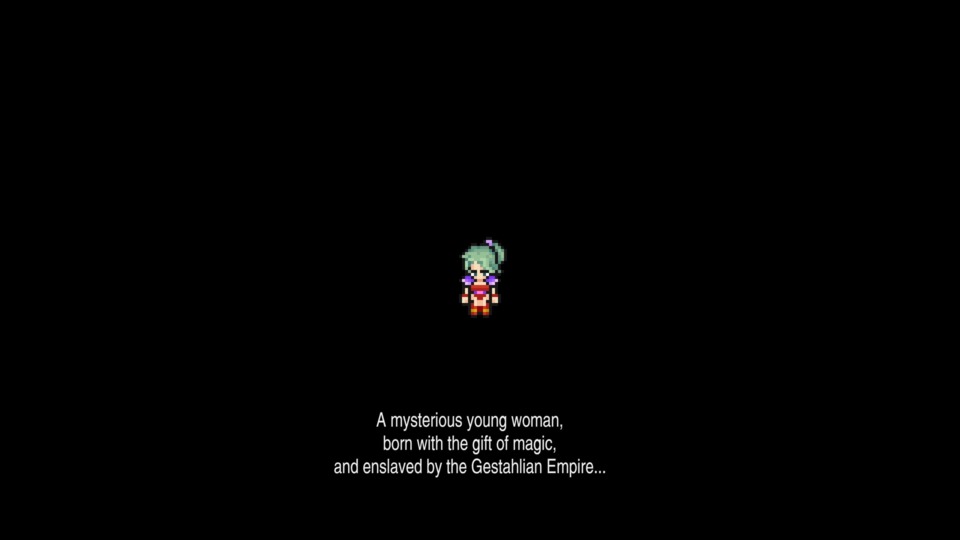
There's also a pace to the game's opening level that makes it one of the strongest to this day. The entire sequence at Narshe to the getaway from Figaro Castle represents a mere two to three hours of my playtime. However, the introductory set pieces are so rampant in elaborate details that they felt longer than they were. All you do in Narshe is move forward, but the pace at which you blow through the defending guards makes it feel more poignant. When you reach the esper, you already understand a power imbalance between the Empire and the rest of the world exists. Therefore, if the Empire gets even a tiny feather in its cap, it could still present massive consequences to the rest of the world. Another example of the game's stunting involves how frequently it injects gameplay variety when you least expect it. With the introduction of Locke, the game showcases how it plans to break up the usual slog of exploring dungeons with a brief tower defense minigame involving an army of Moogles.
Finally, this and the subsequent getaway from Figaro Castle do an AMAZING job of showcasing the mechanical differences between your party members. You spend more time than I would like with just Terra, Locke, Edgar, and Sabin. No matter, there's no doubt that the game presents each character's gameplay gimmick in a prompt but effective fashion. Likewise, their vignettes take advantage of their individual gameplay mechanics and allow for a decent amount of practice before the game starts to expect you to get your shit together. It took me a while to feel comfortable about Sabin's Blitz system. Still, once I was, he became a murder machine that I kept in my rotation almost to the very end. And the game does a great job of making you feel like you are controlling a scrappy group of venerable badasses. The most obvious example has to be when you start Sabin's route when the party splits up, and he blitzes a goddamn ghost train.
Part 3: "But ZombiePie, Don't You Hate The ATB System?"
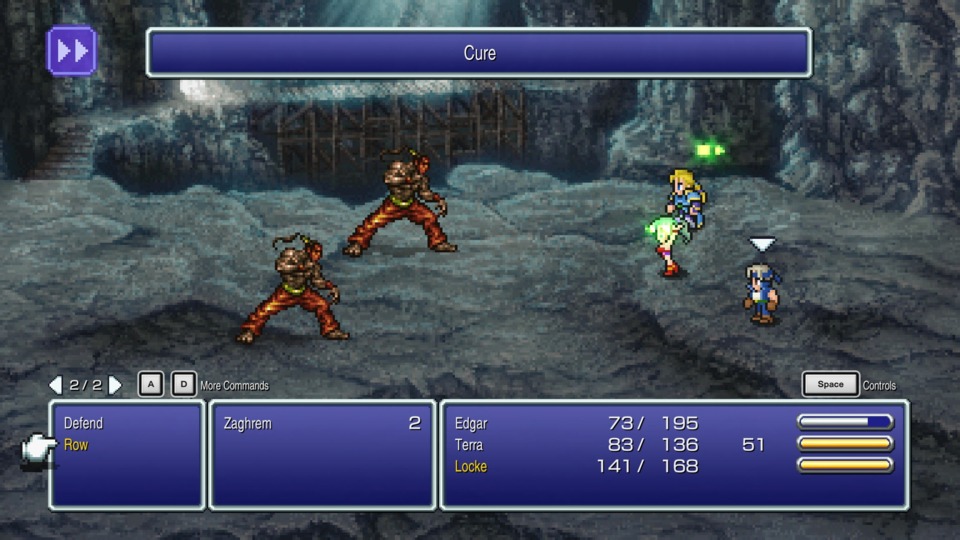
I briefly mentioned my less-than-great run-ins with the Final Fantasy sub-Reddit during the introduction, but let's explore that more. Part of the reason is that I have a reputation for hating the ATB system, and I want to "set the record straight" on that. I do not hate the ATB system during the 8-bit and 16-bit eras. What I appreciate less is how the combat system overstayed its welcome for three console generations when Square desperately needed to mix things up, especially during the switch from the SNES to the PS1. I feel that Final Fantasy VII is the last Final Fantasy game that had any right using the ATB system. With Final Fantasy VII, I can imagine the difficulty of transitioning Final Fantasy from 2D to 3D was hard enough that I can allow them to pass on rocking the boat. From that game forward, Squaresoft should have explored different combat engines that worked better with the high-flying cinematic aspirations of its directors. By Final Fantasy IX, I can honestly say I tolerate the ATB system for an otherwise enjoyable story. That said, IX is not a game I enjoy playing because the game struggles to process its character's decadent attack animations and exorbitant special moves.
With Final Fantasy VI, the ATB system works as intended for the most part. Again, playing the game without magic or espers for what feels like ten hours was a creative choice, but one that I think leads to pacing issues during the World of Balance. Nonetheless, it is an almost perfect system to showcase the inherent and intrinsic differences between the characters. And before you ask, Square-Enix has officially thrown in the towel regarding "Wait" versus "Active." In the Pixel Remaster, the game defaults to "Wait" because, at this point, Square-Enix KNOWS no one plays Final Fantasy games set to "Active." For those that have no idea what I am talking about, for Final Fantasy games that use the ATB mechanic, the game features two settings for battles (i.e., "Wait" and "Active"). Setting the ATB system to "Wait" will cause the ATB meter to pause after taking time to fill up. You can scan your possible enemy targets and process your options more leisurely. Active mode is when the ATB gauge fills up no matter what happens in the battle. Only monsters play old Final Fantasy games set to "Active."
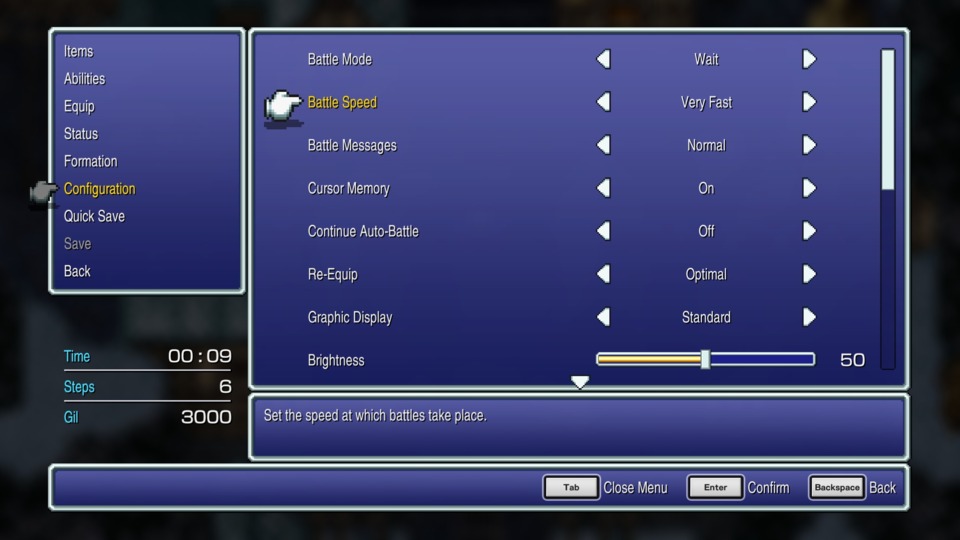
Overall, I consider the World of Balance the better-paced half of Final Fantasy VI. Its set-pieces progress naturally, and as the player, you only experience brief spurts of the usual unfair JRPG bullshit. Until the Floating Continent, I can count on a single hand the number of times I saw a "Game Over," and the few times I did, were my fault. However, it does have one critical weakness. This game takes its sweet-ass time to open up its mechanics, especially its Esper-based magic system. Anyone who tells you to grind at Lete River by taking advantage of the infinite loop exploit is a fucking idiot. Sure, you can get Sabin's Fire Dance Blitz early, but deliberately racking up experience points BEFORE you get the Espers feels like a waste. Likewise, the point where the magic system opens up is a solid five chapters removed from when you start playing the game. As a result, characters like Locke and Cyan, who have primarily un-involved special commands, are far less compelling to play for the first four hours.
Speaking of characters that are way less interesting to me than others, let's talk about Gau and Strago! If there were examples of Final Fantasy VI's ATB system biting off more than it can chew, it is these characters. First, I do not know whose call it was, but the Pixel Remaster changed the names of the Blue Magic spells to be more "authentic" to their Japanese names, which fucked me up. Likewise, fanning through Gau and Strago's magic list continues to be a pain in the ass because of the insane amount of useless shit. For this blog, I put in more effort to collect abilities for both than in previous playthroughs of Final Fantasy VI. I can say that people who talk up a big game for Gau are correct, but they are also people who do not value their time. Like many, I usually rely on Bio (Great Malboro), Catscratch (Stray Cat), and Sonic Boom (Satellite) when using Gau. However, getting The Veldt to make your life marginally enjoyable is a fool's errand. You are bound to toil away trying to get specific enemies to spawn after hours of aimless wandering. Also, I will die on this hill, but the game should allow you to collect every Rage between Gau's initial Leap and when he returns. With Stargo, the poor fool is a painful example of the "Late Character Syndrome." By the time he joins your team, you already have full-featured party members that don't require additional busy work. Additionally, the random encounter and ATB systems do not make getting him up to par easy. Worse, getting what you want for him can tack on hours to your playthrough.
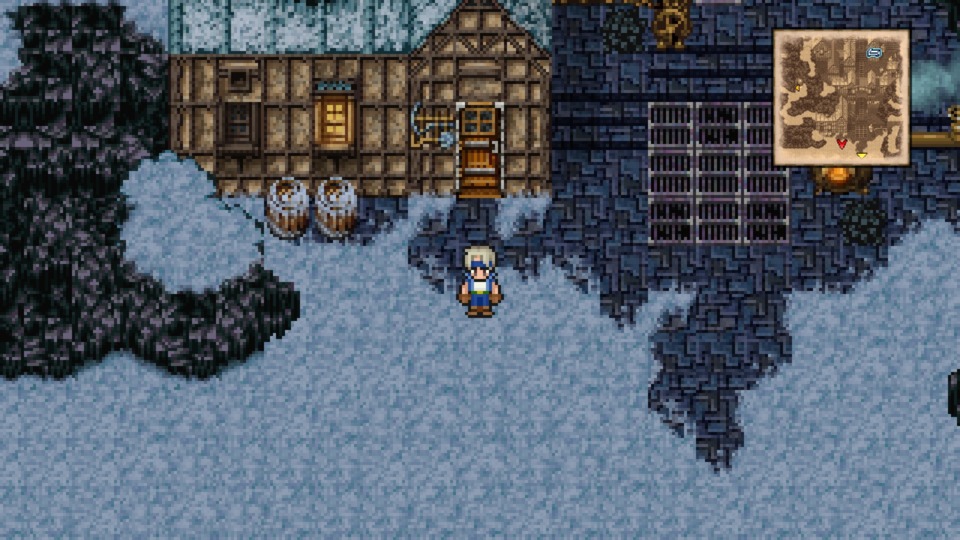
To continue with my give-and-take discussion of the game's early combat, it goes without saying that Final Fantasy VI has more good dungeons than bad ones. However, that's not to say that it isn't free from some crummy old-school JRPG dungeon-crawling quirks. Unless you take the time to grind out experience points to unlock abilities or tools, Final Fantasy VI initially has the same mechanical downside as its predecessors. Because your ability to utilize magic is limited to Terra and Celes, your party's crowd control options are severely limited. As a result, your most significant "Game Over" threats are random encounters instead of the in-game bosses. Sure, there are tricky to downright cruel bosses in Final Fantasy VI, which we will discuss in future episodes. However, my experience in Final Fantasy VI was no different from Final Fantasy I or V. Trash mobs that spew status effects or high damage attacks are SIGNIFICANTLY HARDER than anything else in the game. Likewise, there are some serpentine dungeon floor plans in this game that are no fucking fun to play, and the game doesn't exactly make a great first impression with Mt. Kolts.
Part 4: An (Almost) Perfect Example Of An Ensemble Cast Done Right
The other significant storytelling aspect of Final Fantasy VI that doesn't get as much appreciation today as it should, is the ensemble nature of the cast. While most modern Final Fantasy products today frame Final Fantasy VI as "Terra's story," playing the game reveals that the opposite is true. Final Fantasy VI is as much Locke's, Sabin's, Edgar's, etc. story as it is Terra's story. Each party member is a primary actor at least once in the game. The story arcs and characterization they get are each presented as equally important as the next. Other characters (i.e., Biggs, Wedge, Banon, Leo, etc.) occupy guest roles and blink in and out of the story. Yet, the game still treats them with as much reverence and respect as the characters you follow from beginning to end. I can honestly tell you more about Banon or Leo while avoiding describing what they look like than the majority of Final Fantasy XIII or XV's primary cast.
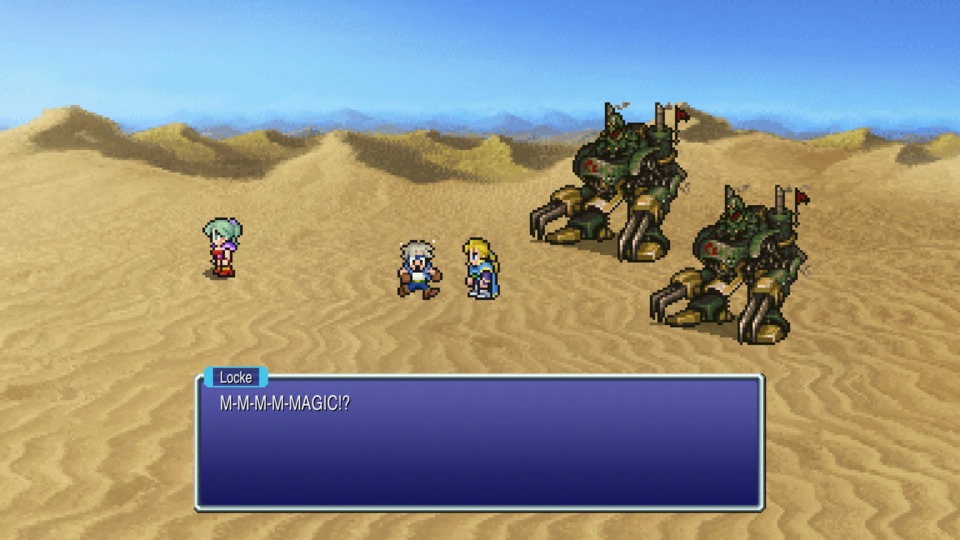
The game almost immediately revels in its ensemble format. After Terra breaks away from Biggs and Wedge and their mind control device, she attempts to make a hasty exit from Narshe. Unfortunately, she falls victim to a trap and needs assistance. The game then transitions to Locke, who becomes the protagonist of his own game. He attempts to dodge guards while trying to apprehend Terra but also muses about perusing the cave for untold treasures. We understand Locke's job class, character quirks, and personality in what amounts to a fifteen-minute sequence. We also understand how each character is mechanically different from one another as Locke's "Steal" command replaces Terra's "Magic" option. There's also a short bit where we get a brief cameo involving Mog. Speaking of which, the minigame in the Narshe caves adds some much-needed levity and gameplay variety. For the most part, Final Fantasy VI differentiates most of its dungeons through special gameplay hooks and one-off sequences when you first explore them. As a result, there were only a few occasions when I dreaded exploring dungeons in the entire game.
Then there's Kefka. Much like the death of Aerith in Final Fantasy VII, modernity has spoiled much of Kefka's appeal. At face value, Kefka is a trope. He's a cackling mustache-twirling goon who later reveals himself as the story's primary antagonist. Much of what we think is canonical to his behavior and motivations are not present in Final Fantasy VI and are instead by-products of supporting media. However, he is still a fantastic character. Like a Shakespearean actor trapped in a schmaltzy popcorn flick, he commands the center stage whenever he talks and chews through the game's scenery like his life depends on it. His mannerisms are unlike any other character, making him all the more memorable. Those quick and quirky mannerisms are what I think have resulted in people claiming he's a bigger deal in the story than in actuality. For more than half the game, he's a two-bit jester whose main gimmick is that he keeps fucking up whenever the Emperor asks him to deal with the Returners. Correspondingly, the "surprise" that he's the REAL big bad isn't nearly as revolutionary as some make it seem. When you compare Final Fantasy VI to its five predecessors, you realize it's less about reinventing the wheel and more about making a version of the wheel for a Porsche 911. The Final Fantasy franchise has always pulled the rug from underneath you when it comes time to reveal the main antagonist. If anything, Kefka is another example of Final Fantasy VI's stunting, as he's one of the best examples of this trope up to this point.
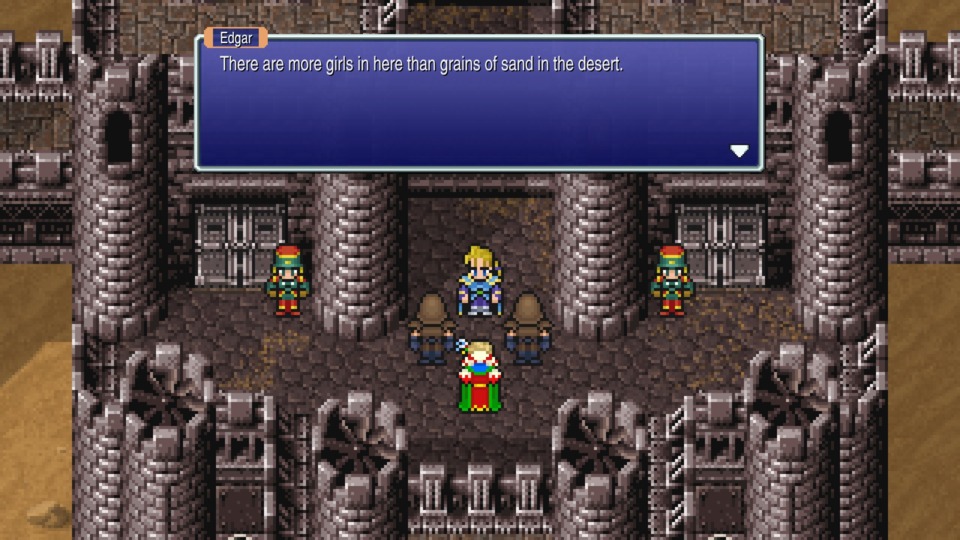
Next episode, I plan to discuss the importance of Ted Woolsey's original translation and how much of what has come to define Kefka comes from Woolsey's interpretation. Overall, I felt the Pixel Remaster's translation was a notable improvement over the original SNES translation, which I know was a by-product of the times. For example, the characters of Final Fantasy VI finally say "damn" and "Hell" in English. With the Pixel Remaster, many of Woolsey's "rough edges" have been sanded off, and that's a good thing. The Pixel Remaster has made corrections that are bound to get some fuming, but that's par for the course. I know some people are upset Kefka doesn't say "Son of a submariner" in this version. However, the entirety of what is here is far better than what we have seen before.
If there is one criticism about the world-building up to this point, the game feels like a series of vignettes rather than a "whole" story far longer than it should. Worse, some of these vignettes are missable, and missing some of these scenes is a bummer unless this is your second or third rodeo. One of my favorite in-game moments is the coin-toss scene with Sabin and Edgar. This awe-inspiring character-building moment is missable if you decide not to return to Figaro Castle after the party split. And depending on how you prefer to play the game, you might not have either running around in your primary team. That presents another minor nitpick I have with the first "half" of Final Fantasy VI. While the "World of Balance" doesn't actively punish you for picking an "A-Team" when you progress the story or attempt side quests, the "World of Ruin" certainly does. I did NOT use Celes a ton during my playthrough and forgot how much of a bad idea that was until it was too late.
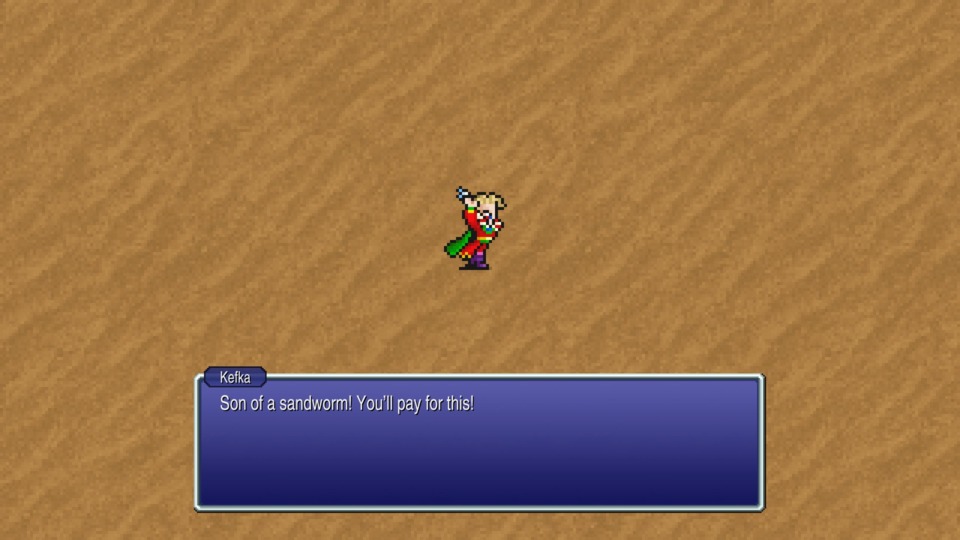
Part 5: I Don't Love EVERYTHING About This Game!
I'm going to shoot my shot right now; I hate the relic mechanic. Since finishing the game, I have flip-flopped back and forth on the relics. While I agree with the general sentiment that they help you organically explore character class hybrids, the relics are way too fiddly to use. That problem is especially the case towards the mid to late-game, where dungeons force you to split up your party or swap between groups of characters. I found it to be a colossal pain in the ass to flip between the same eight or nine characters and menu screens to de-equip one cadre so I could re-equip another. Even when using the random guy in the airship to unequip unused party members, I still felt like I was spending between five to ten minutes fiddling around with relics and menus when trying new party combinations. The "Auto Equip" feature, which has existed since the original SNES release, only goes so far as it doesn't touch relics or Espers. As a result, I desperately wished the Pixel Remaster version had an option to save templates or specific equipment and relic combinations. And I know this is going to sound "spoiled," but I wish the Pixel Remaster had an EXP sharing toggle. That way, I wouldn't need to drop everything in-between chapters to level up new party members from time to time.
Another quibble I have struggled to pen into words stems from the character classes. The signposting on what the implied class or "job" for each character might be isn't the best. Likewise, how relics impact the utility and functions of each character's job, or stats is confusing, especially for newcomers. But it is the game's smattering array of character progression sub-systems that drives me crazy most of all. Each party member gains new abilities and special moves differently from the other. Some, like Sabin or Cyan, require you to grind away and complete a character mission in the World of Ruin to see all of their abilities. On the other hand, Edgar and Locke need you to explore various merchants and environments for high-tier equipment. The bane of my existence, Setzer, gains their alternate move by equipping a different relic that is easy to pass over if you are not careful. Then there are more abstract characters like Relm, Mog, Strago, Gau, and Gogo. The game doesn't do a great job of tutoring how to get the most out of these characters. In the case of Relm, her initial ability (i.e., Sketch) gets a tutorial. Still, her far more helpful alternate (i.e., Control/Charm) gets jack shit. Also, some characters are better than others, and it sucks when the game forces you to use those less-than-ideal characters (i.e., Setzer).
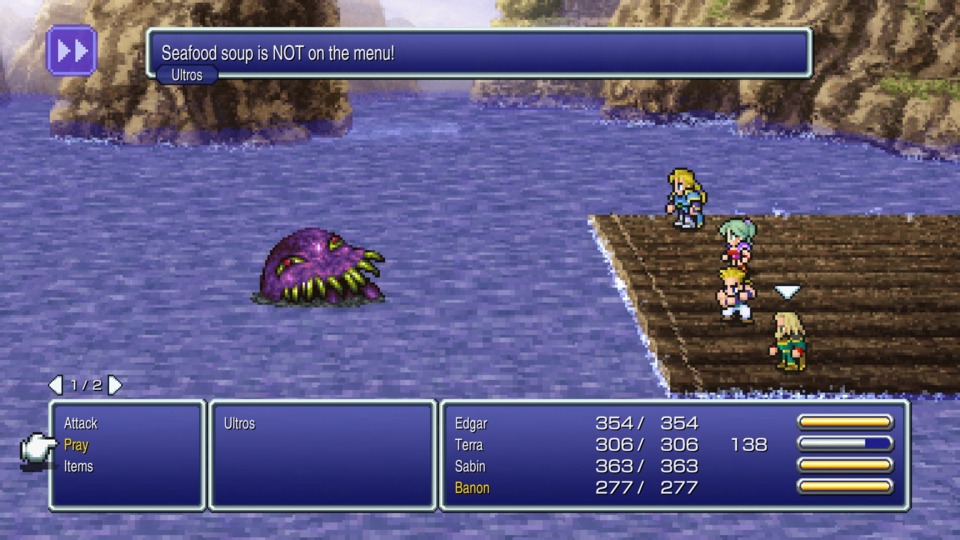
Transitioning to the subsequent story set-piece at Lete River leads me to one of the game's many positives. The pseudo-vehicle sequences, even those that do not involve Mode 7, are snappy and highly cinematic. Your first impression of Ultros is equally impressive, with the game conveying reactive dialogue during an ATB fight. If there is one complaint worth bringing up, it must be the Pixel Remaster boss dialogue prompt. Again, the readability of the default font rears its ugly head. More importantly, the sizing feels "off" for every boss fight where the characters speak to one another. The prompts on modern monitors feel significantly smaller than on the SNES or GBA versions. To highlight why this is an issue, I missed the first part of Kefka's "Life, dreams, hope" speech because I was faffing about my battle options and did not know the cutscene triggered. Otherwise, that octopus was a delight when I first played this game, and he continues to be a highlight in the Pixel Remaster, thanks to his iconic linguistic tropes.
The party split, to me, is another example of the game flexing its muscles, albeit less successfully. Honestly, I wasn't that impressed when I first experienced it, as the pacing with the party split after the Ultros fight has always felt weird to me. Continuing with Terra and company on the raft maxes out at ten to twelve minutes. It does almost nothing to service the characters in that segment, and I'm still shocked at how little meat is on the bone with that one. Locke's mission is fucking annoying as fuck, but credit to the design team for trying something different. Locke's escapade at South Figaro is a stealth mission with few random encounters until you reach the prison containing Celes. The issue is that while navigating environments in the Pixel Remaster is slightly better, thanks to quality-of-life features, it's STILL not the best. The entrances to buildings and the starts and ends of scaffolds can still be hard to parse out at times. Similarly, some parts involving backtracking and uniform swapping can be hard to pick up on if you don't know where to go. That said, it's an admirable tutorial on Locke's "Steal" command.
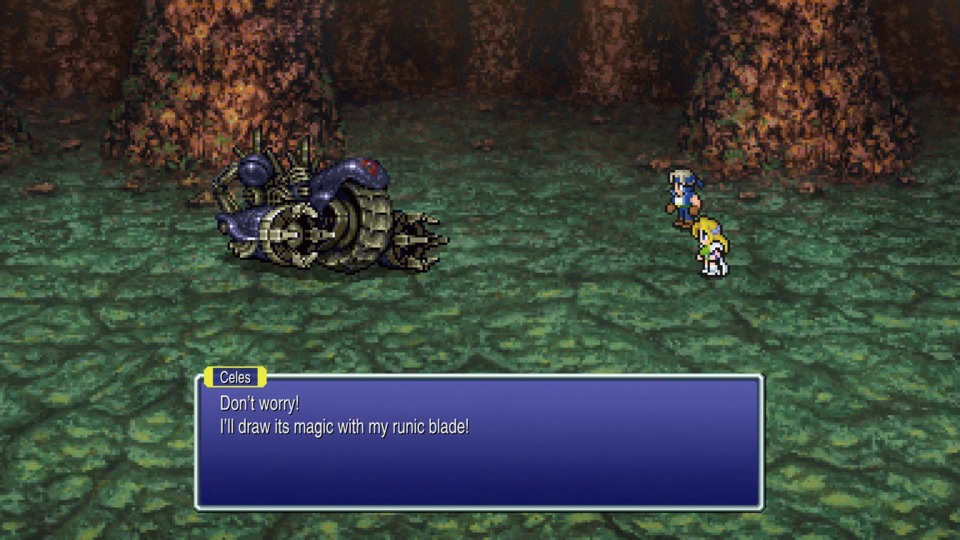
Finally, to return to my previous rant about the ATB system, we have to talk about the forced moments when you have fewer than three party members. This sequence is not the only time you need to shuffle along with one character while dealing with random encounters. However, this set piece with Locke feels even more heinous than the segment with you soloing with Celes in the World of Ruin because of how half-baked Locke is at this point. In Final Fantasy tradition, the success rate on his Steal command is dog shit, and he barely inflicts enough damage for you to get by single enemies. When you finally get Celes, she improves things only slightly, considering how much of a glass cannon she can be. Speaking of Celes, I despise her "Runic" ability because it is so situational from start to finish. Even when it can be helpful, getting the timing down is finicky. More often than not, after popping Runic, the timing would not be correct, and my turns with Celes were largely pointless. Luckily for all involved, Sabin's Route is a tour de force of badassery, and the Pixel Remaster does it (mostly) justice. However, that will be where we pick up next time.
